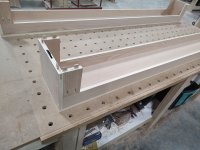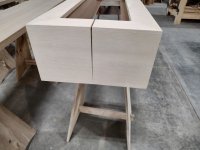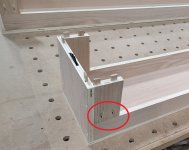Crazyraceguy
Member
- Joined
- Oct 16, 2015
- Messages
- 5,503
I have built a lot of mantels over the years, some with vertical surrounds, some just floating, ornate with crown moulding and others that are just barn beams, but I have never done one that was double sided.
I have seen fireplaces like that, usually gas units in retail locations or restaurants.
This one goes to the car dealership that I have been working on for the last few weeks. Why the veneer? I don't know. The rest of the job has been a handful of laminate (HPL) colors.
The main boxes are just a shell to cover existing support blocking. It's just 3/4" plywood halves that are aligned with Dominos and snap together with some Lamello Clamex connectors. The veneer is some really good looking rift white ash. Sadly though, it is going to get stained to match one of the laminate colors.
You would be forgiven if you missed the seam. It happened to someone at the shop today. I was asked if I veneered over the joint, so it couldn't come apart. I knocked it apart to show him....stunned. I just hope it remains that good after it gets stained. The edges are "end grain" so they may darken more?
I just wish that the veneer would have been long enough to wrap around the corners, but it was only 8' sheets.
I have seen fireplaces like that, usually gas units in retail locations or restaurants.
This one goes to the car dealership that I have been working on for the last few weeks. Why the veneer? I don't know. The rest of the job has been a handful of laminate (HPL) colors.
The main boxes are just a shell to cover existing support blocking. It's just 3/4" plywood halves that are aligned with Dominos and snap together with some Lamello Clamex connectors. The veneer is some really good looking rift white ash. Sadly though, it is going to get stained to match one of the laminate colors.
You would be forgiven if you missed the seam. It happened to someone at the shop today. I was asked if I veneered over the joint, so it couldn't come apart. I knocked it apart to show him....stunned. I just hope it remains that good after it gets stained. The edges are "end grain" so they may darken more?
I just wish that the veneer would have been long enough to wrap around the corners, but it was only 8' sheets.




